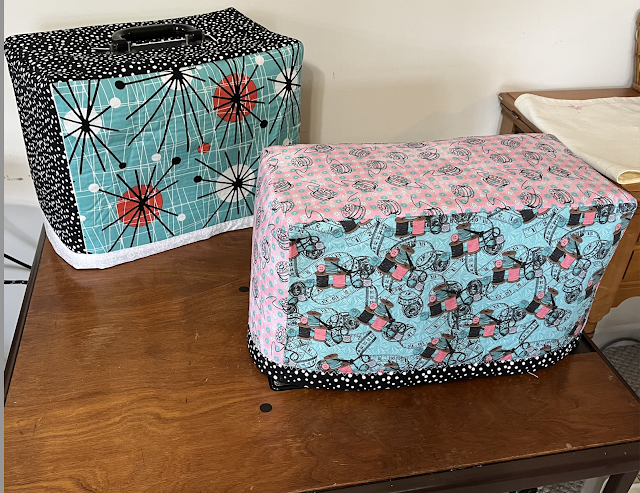Finally, here is my pattern for making a cover for your Featherweight case. This does not enclose the case at the bottom, but just covers it to protect it from dust, scratches, and scuffs.
 |
| This fits the newer style case from about the 1950s. The older ones, with the tray insert, have slightly different dimensions, so substitute your own measurements if necessary |
From the lining/contrast fabric:
Front/Back: cut 2 @ 15-3/4" x 13-1/8"
Sides: cut 2 @ 9-1/4" x 13-1/8"
Top: cut 1 @ 15-3/4" x 9-1/4"



From the main fabric and the fusible fleece:
Front/Back: cut 2 @ 15-3/4" x 11-5/8"
Sides: cut 2 @ 9-1/4" x 11-5/8"
Top: cut 1 @ 15-3/4" x 9-1/4"
Trim away 1/2" seam allowance before fusing the fleece in order to reduce bulk in the seams. (NOTE: There is no seam allowance at the lower edge of the Front, Back, and Sides.)
Now cut out a 6-1/2" x 1" rectangle from the center of each Top section as shown:
On each piece, mark the corners with small dots at the seam allowance as shown. NOTE: Seam allowance is 1/2"
 |
| Mark dots on corners at seam allowance (1/2" x 1/2") |
To Sew
With Main fabric, sew Front and Back to Sides, stopping exactly on dots, and back stitch to reinforce. Press seams open.
Using the top cut from Contrast fabric, pin to the Sides, matching dots. Begin and end seam exactly on the dots, and backstitch to reinforce. These should meet at a perfect right angle, as shown below.
After Top is sewn at both Sides, pin it along Front/Back edges, folding back the seam allowance from the previous seams and matching dots. Begin and end these seams exactly on the dots, reinforcing with backstitching as before.
 |
| Fold back previous seam allowance |
You can slip this on over the case to help you shape it and lightly press the seams open (Careful, don't scorch your case!) Trim corners, if you want, to make a neater finish.
Sew Lining in the same way with remaining pieces, then press under 1/2" on bottom edge.
Now, put the Main cover back on the case right side up and the Lining over it right side down (right sides together, in other words). Match the openings and pin as shown
Sew around this opening about 1/4" from opening edge. I used the wide toe of my presser foot as the guide. (You have to turn it inside out to get in there to sew) Reinforce at the corners as you turn.
Slash right up to the stitching at the corners and trim
Pull the lining through the opening, then you can put this back on the case to press it. (Again, not too hot, you don't want to damage the leather of your case!) After pressing, topstitch around opening if desired.
With cover on the case pull Lining down tautly all around. It will extend 1-1/2" beyond the bottom (with 1/2" previously pressed under.) Turn this back up over the exterior and pin into place all around, matching corners first.
Insert piping between the layers if desired and sew the reverse hem with a zipper foot.
Or sew the hem down with a decorative stitch, blind hem stitch (like an appliqué), or whatever you want.
And here is a variation of the Case Cover, which is a Machine Cover (or Cozy) to cover your Featherweight while it's not in use.
Case Cover and Machine Cover
The instructions are exactly as for the Case Cover except to substitute the following measurements (and of course, you leave off the opening for the handle):
FINISHED SIZE: 16" long X 8.5" high X 7.5" wide
Exterior Fabric:
Top - 17" X 8.5"
Front/Back - 2@ 17" X 9.5"
Sides - 2@ 8.5" x 9.5"
Lining Fabric:
Top - 17" X 8.5"
Front/Back - 2@ 17" X 11"
Sides - 2@ 8.5" X 11"
OPTIONAL: To give the machine cover more structure I interlined it with flexible foam. After sewing the Exterior together, I cut pieces of foam to fit each of the top, sides, front/back sections (use finished size measurements) then used spray adhesive to glue them into place before inserting the lining.
That's it! If you make this, I'd love for you to send me a photo.






















